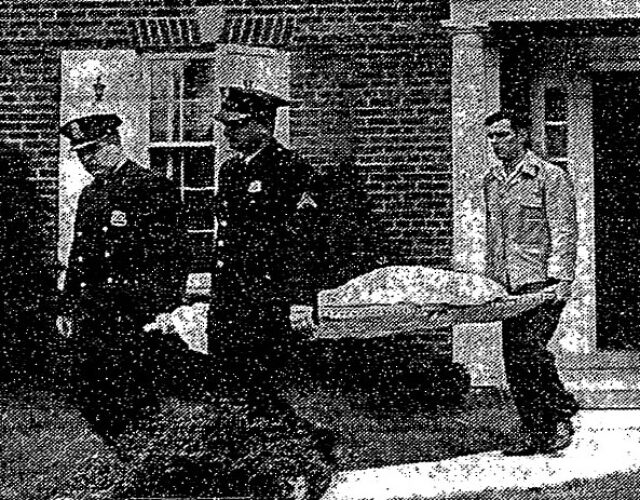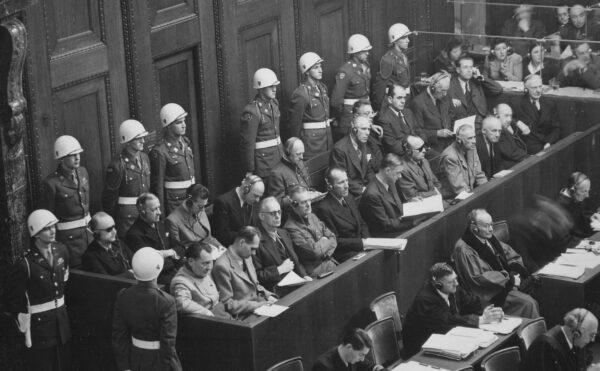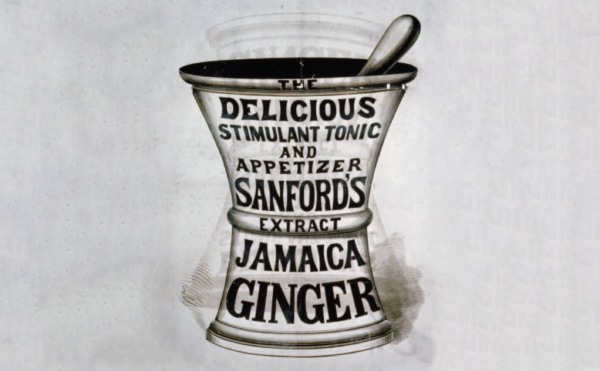Paul Stoutenburgh knew more atomic secrets than anyone on Earth. So was that why he killed himself? And if not, why was the government (seemingly) so uninterested in getting to the bottom of his death?
About The Disappearing Spoon
The Science History Institute has teamed up with New York Times best-selling author Sam Kean to bring a second history of science podcast to our listeners. The Disappearing Spoon tells little-known stories from our scientific past—from the shocking way the smallpox vaccine was transported around the world to why we don’t have a birth control pill for men. These topsy-turvy science tales, some of which have never made it into history books, are surprisingly powerful and insightful.
Credits
Host: Sam Kean
Senior Producer: Mariel Carr
Producer: Rigoberto Hernandez
Audio Engineer: Jonathan Pfeffer
Transcript
Paul Stoutenburgh walked into his office and froze. Something wasn’t right. But what?
He looked around. Stoutenburgh worked as a patent lawyer for the highest-profile piece of technology in the world in 1946—the atomic bomb. All the details of its construction, all the blueprints, were right there in his office. It was the highest concentration of nuclear secrets in the world.
Which of course would make his office a prime target for stealing secrets. And the pressure of keeping everything secret was eating at Stoutenburgh.
Right now, for instance, he swore something was wrong. But what? He examined every item on his desk. You can imagine him thinking, Is that where I left my stapler yesterday? Did someone move it? He strained trying to remember.
Next he’s holding things up to the light, then peeking under his desk. Any fingerprints or footprints? Any signs of a break-in?
Then he saw it. He picked up some files—and found a folder he’d been looking for yesterday. He had searched his whole office yesterday, and couldn’t find it. And now here it was. Had he simply overlooked it? Or had someone taken it and put it back?
He tried to think. Maybe he had just slipped this folder among the files and forgot. Or was this the proof he needed? But again, he just couldn’t remember.
Which only made him angry. Perhaps he slammed the folder down. Something was going on—he was sure of it. But what?
The thing was, Stoutenburgh was right. Something was going on. He was slowly being driven mad by paranoia. Paranoia that would soon destroy him, and lead him to shoot his wife and daughter. And to this day, no one knows why.
Was he simply trying to protect them? Or was he caught in the web of something bigger—something darker, and more deadly, related to those atomic secrets?
***
The idea of patenting an atomic bomb seems faintly ridiculous. Usually you patent something for commercial protection, so you can sell it and make money. But the U.S. government obviously wasn’t peddling atom bomb cores. So why patent the bomb’s components?
A few reasons. First, to credit the scientists involved. They’d worked hard on the bomb, and wanted recognition. And when you patent something, you list the inventor. Credit where credit is due.
Second, the U.S. government wanted to push the related technology of atomic power after World War II. Patenting the various components would ensure that they remained a public good.
But patenting had big downsides as well. First, you have to submit a blueprint for building every part of an atomic bomb. What if those blueprints fell into enemy hands?
Even worse, during the Manhattan Project to build the atomic bomb, everything—everything—was compartmentalized. Each scientist involved knew only one tiny bit of the big picture, but nothing more. And what they did know they kept secret.
Now, this secrecy led to constant fights and frustration. Scientists are more curious than cats. They love asking questions and tossing ideas around. Why this, why that, why, why, why? It drove them batty to run into walls of secrecy. But the military insisted. Secrecy ensured that no one person could put together a bomb themselves.
However, patenting the bomb worked against that secrecy. Overall the government filed 2100 separate patent applications for different bomb parts. Inadvertently, this process gathered all those atomic secrets in one place. And that one place was Paul Stoutenburgh’s office.
Stoutenburgh was born in Ohio in 1901. He had a wide face with a sleepy smile and slicked back auburn hair. In the 1920s, he earned a law degree in Washington D.C. There, he also met his wife Anna, and in 1934 they had a daughter named Mary Alice.
Stoutenburgh joined the army very late in the War, in July 1945. Seven months later, he resigned from the army and joined the government agency in charge of the Manhattan Project. His job involved managing the agency’s secret atomic patents.
Frankly, the job did not go well. Working with atomic secrets changed Stoutenburgh. Friends recalled him saying strange things. Claiming that papers and items would go missing from his desk one day and mysteriously reappear the next. He sounded paranoid.
The obvious worry here was Soviet spies. Although the U.S. and Soviet Union were allies during World War II, the two nations quickly turned on each other afterward and became enemies. And Soviet leader Joseph Stalin was desperate to get his own atomic bombs, by hook or by crook. Or by espionage.
This wasn’t just speculation, either—a maybe. In September 1945, a clerk at a Soviet embassy in Canada defected. In doing so, he stole reams of documents that revealed extensive Soviet spy rings in Canada and the U.S. This included spies in agencies working on atomic bombs.
Frustratingly, the documents were light on details. No one knew who the moles were, only that they existed. But that just made people in the atomic field more paranoid. Anyone—anyone you worked with—could be a spy.
Fear of spies began to eat away at Stoutenburgh’s brain. After all, papers were going missing from his desk. At least he thought so. Regardless, he begged his bosses to tighten things up.
It’s not clear what he recommended specifically. Perhaps fatter locks on the doors, or stricter control over who saw what. But we do know his bosses’ reaction. They ignored him. They did nothing.
Which crushed Stoutenburgh. Here he was, trying to protect his country—his family—from menacing Soviet spies. And no one cared.
He soon grew depressed. And he began to deteriorate mentally. There are reports of him scrawling equations on the walls of his home. No one knows why.
And sadly, Stoutenburgh couldn’t keep his paranoia and fear bottled up. He soon lashed out in the worst possible way—on his innocent wife and daughter.
The tragedy started to unfold with a telephone call. It was Sunday, March 31st, 1946. Twelve-year-old Mary Alice Stoutenburgh had a play date with a friend to go roller-skating. But Mary Alice never showed up. So the mother of her friend called Anna Stoutenburgh, Mary Alice’s mother, to see what happened.
The mother listened to the phone ring—and ring—and ring. No one picked up. It wasn’t like the Stoutenburghs to flake out like this. So the mother called up Anna Stoutenburgh’s brother. She asked if he had heard from Anna recently. He had not. So he agreed to visit the Stoutenburgh home in Northwest DC to check on them.
Even from the outside, things looked bad. Two newspapers were sitting on the front step. Then the brother peeked into the garage and saw the family car. So the Stoutenburghs were not away. Fighting down his panic, the brother called the police.
The police came right over. They broke a window in the back door and entered. The first floor was eerily quiet. Then they trudged upstairs, and walked into a bloodbath.
They found the first body in the hallway. Lying half-in and half-out of one bedroom was Anna, the wife and mother. She was wearing a black coat, and had a bullet wound to the back of her skull.
Inside the room, the police found Stoutenburgh sprawled across the bed. He was wearing pajamas and a smoking jacket. The right temple of his skull was blown to bits. A.25-caliber pistol was lying near his hand.
Saddest of all, the police found little Mary Alice on the far side of the bed. She also had a bullet wound to the temple. Then the police looked closer. To their shock, they realized she still breathing! She must have been lying there for over 24 hours. But she was still alive.
The police rushed Mary Alice to Walter Reed Hospital. Doctors there did their best to revive her. But she was too far gone to save. She never woke from her coma and died a week later.
This triple death left the Stoutenburghs’ friends and family in agony. What happened? What went wrong?
The obvious answer was that Paul Stoutenburgh had finally snapped. His paranoia about spies and leaked secrets had been deepening for months. Perhaps he’d finally grown convinced that America’s enemies would soon have the bomb. After that, the world could hardly avoid a nuclear war—a nuclear holocaust. The pain and suffering would be unimaginable. So perhaps Stoutenburgh decided to kill his wife and daughter in a twisted act of mercy—to spare them from the terrible future he foresaw.
But while that was the obvious answer, was it the correct one? Not everyone thought so.
In the months and years afterward, rumors began swirling about the Stoutenburgh tragedy—things that didn’t quite add up.
For instance, the police found Paul Stoutenburgh next to a .25-caliber pistol. But people claimed that he didn’t own a .25-caliber pistol, only a .45-caliber one.
Moreover, Stoutenburgh had joined the army late in life. And while he went through some training, he was reportedly a terrible shot—a horrible marksman. But he’d clearly gunned down his wife. She’d been fleeing, probably panicked, yet he’d taken her out with a single round to the back of skull. How did a poor marksman make that shot?
Now to be clear, the rumor about him not owning a .25-caliber pistol is just that—a rumor. Maybe he owned one and didn’t tell anyone. And maybe he just got lucky in gunning down his wife. But those things do give you pause.
And those weren’t the only suspicious things. The Manhattan Project was pretty much the embodiment of paranoia over security. As one historian said, “If you even sneezed near Los Alamos during World War II, the Manhattan Project security people would have opened a file on you.” In fact, in some ways, Stoutenburgh’s paranoia didn’t really stand out. Lots of people in and around the Manhattan Project were obsessed with security.
In perhaps the strangest incident, the Manhattan Project investigated Superman—the comic book character—as an atomic spy. I’ve put together a bonus episode about this at patreon.com/disappearingspoon. It’s a nutty story involving Hitler, the SS, even Santa Claus. All that and more at patreon.com/disappearingspoon.
Given that paranoia about security, you’d think that Stoutenburgh’s death would have caused panic in government circles. After all, the man had access to more atomic secrets than anyone alive, and he had just died suddenly and violently. That’s probably worth investigating. Odds are he simply snapped. But better to make sure, right?
Except—as far as anyone knows, there was no investigation. Military intelligence, the FBI, the precursor to the CIA. They just shrugged. None of them even looked into Stoutenburgh’s death.
At least not officially. A few years ago, a historian started poking into the Stoutenburgh affair. He found that the FBI did have a file on Stoutenburgh. But the FBI destroyed the file in 2001. No one knows why.
Now, the destruction of the file says nothing by itself. The FBI destroys old files all the time for boring, bureaucratic reasons. Who knows, maybe someone just needed a file cabinet and started purging. Then again, the FBI holds onto a lot of old, useless files as well. Why destroy Stoutenburgh’s? Was something in there?
Now, I don’t want to fan the flames of conspiracy here. People have speculated about some wild things. That Stoutenburgh uncovered a KGB plot to steal atomic blueprints, and that the KGB killed him. Or perhaps the KGB simply threatened him, and Stoutenburgh killed himself and his family rather than let them fall into the KGB’s clutches. Or hell, maybe Stoutenburgh discovered an American-led plot of some sort.
To be clear, there’s no evidence for any of that. But the silence around Stoutenburgh’s death—the complete lack of an official investigation—makes a lot of sober people think twice. The man with access to more atomic secrets than anyone in the world suddenly kills himself, and the already-pretty-paranoid officials in charge of the Manhattan Project just yawn? It doesn’t make sense.
But even laying aside a potential conspiracy, there’s something else I find fascinating about this story. Fascinating and heartbreaking.
Let’s use Occam’s razor and assume Stoutenburgh simply snapped. He killed his family because he thought atomic secrets were being stolen and in his twisted mind he wanted to protect them somehow.
But in truth, that whole mad chain of logic was based on a faulty assumption. Because you can make a good case that there was no secret of the atomic bomb. In some sense, the whole idea of secrecy there was a myth.
What I mean is this. There were certainly aspects of the atomic bomb arsenal we didn’t want falling into enemy hands. Especially with plutonium bombs. Plutonium bombs required a lot of intricate, innovative parts. Even the existence of plutonium was secret for a long time, much less how to make it.
Uranium bombs were different. All the scientific knowledge about starting a runaway chain reaction in uranium had been published by 1939—before World War II started. As a result, any competent physics graduate student in the world knew in theory how to make a uranium bomb.
The real barrier to atomic bombs, then, wasn’t secret knowledge. It was material. Atomic bombs require enriching uranium. Which again, is simple in theory. But actually doing so takes ruinous amounts of time, energy, and money. During World War II, it cost well over a billion dollars and required years of work from tens of thousands of people.
To make a uranium bomb, then, didn’t require some hidden knowledge—a secret formula on a blackboard in a locked room. It required machines and factories and people pushing themselves to make really-hard-to-make stuff.
So why was there so much secrecy surrounding the Manhattan Project? Partly to guard the secrets of plutonium. But mostly because the military ran the project, and military people didn’t understand that, at with uranium bombs, there wasn’t much of a secret to guard. Military people were secretive by nature and couldn’t let the habit go.
But to the scientists involved, all the fuss over secrecy seemed irrational and absurd. They knew the enemy would figure things out soon enough—even with plutonium bombs, too. Secrecy could delay the enemy by a few months or a few years. Which can be important. It could win you a war even. But you simply cannot keep the bomb out of enemy hands forever.
And to me, that’s what makes the Stoutenburgh’s case so heartbreaking. He seemingly murdered his wife and daughter from fear of secrets being exposed. But many of those secrets weren’t secrets at all. And they merely exposed the sadly deranged state of his own mind.




